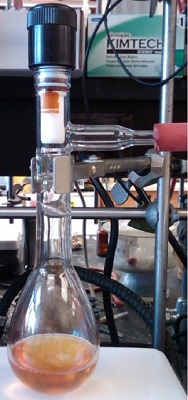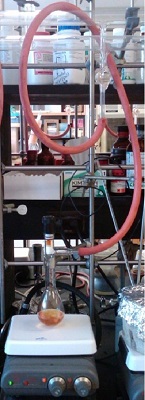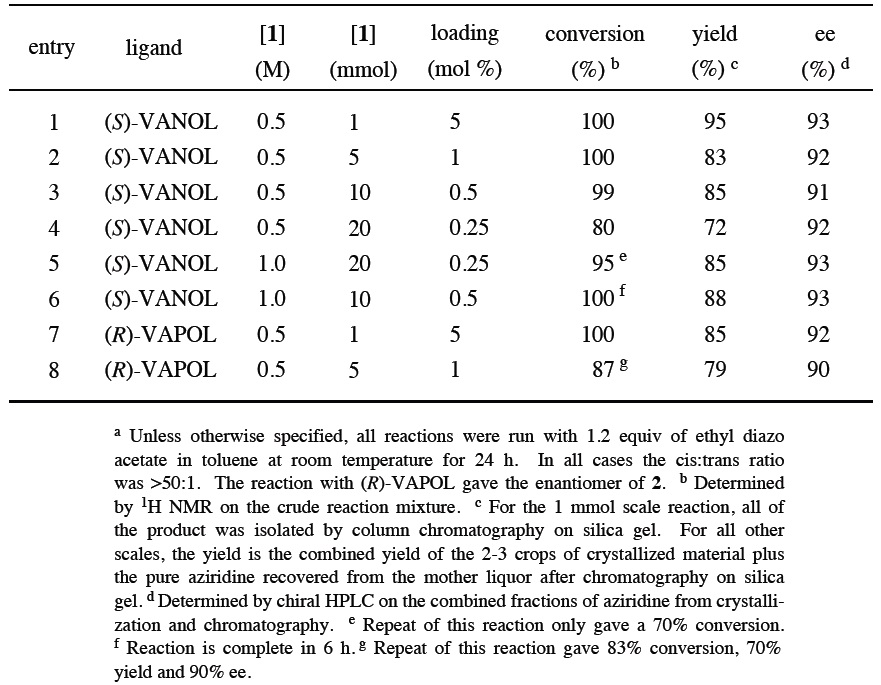Org. Synth. 2011, 88, 224-237
DOI: 10.15227/orgsyn.088.0224
GRAM SCALE CATALYTIC ASYMMETRIC AZIRIDINATION: PREPARATION OF (2R,3R)-ETHYL 1-BENZHYDRYL-3-(4-BROMOPHENYL)AZIRIDINE 2-CARBOXYLATE
Submitted by Aman A. Desai, Roberto Morán-Ramallal, and William D. Wulff*
1.
Checked by Shabnam Kouchekzadeh Yazdi, Gavin Haberlin, and Mark Lautens.
1. Procedure
A.
N-(4-Bromobenzylidene)-1,1-diphenylmethanamine ( 1).2 A 250-mL round-bottomed flask with two 24/40 necks is fitted with a magnetic stir bar (20 mm × 8 mm × 8 mm), a rubber septum, and a 24/40 vacuum adapter. The flask is connected to a double manifold vacuum line with a nitrogen ballast. This assembly is flame-dried under high vacuum (1.0 mmHg) and cooled under a slight positive pressure of nitrogen. To this flask is then sequentially added 4-bromobenzaldehyde (11.84 g, 63.95 mmol, 1.1 equiv) and MgSO
4 (14.0 g, 116 mmol, 2.1 equiv)
(Note 1). This is followed by the addition of 60 mL dry dichloromethane
(Note 1), via a plastic syringe fitted with a metallic needle, along the neck and the sides of the flask such that all solids could be rinsed to the bottom of the flask. The mixture is stirred at room temperature (22 °C) under nitrogen to provide a white slurry. Aminodiphenylmethane (10.0 mL, 56.3 mmol at 97% purity, 1.00 equiv) is then added to the solution through the rubber septum, via a plastic syringe fitted with a metallic needle
(Note 1). The resulting white slurry is stirred at room temperature (22 °C) for 20 h, at which time the reaction is complete
(Note 2). A different 250-mL round-bottomed flask (24/40 single neck) is fitted with a filter adapter and a coarse porosity glass fritted funnel (60 mL, 4.5 × 5.5 cm) packed with Celite (1 cm height). The reaction mixture is filtered through the fritted funnel; the reaction flask is rinsed with dichloromethane (3 × 15 mL) three times, and the rinse is added to the funnel each time
(Note 3). The fritted funnel and the Celite bed are then washed twice with dichloromethane (2 × 15 mL). The fritted funnel is removed, the filter adapter is rinsed with 10 mL dichloromethane, and the solution of the crude product is then subjected to rotary evaporation until dryness (40 mmHg, 45 °C) followed by high vacuum (1.0 mmHg) for 3 h. This afforded the crude imine product as an off-white solid (21.36 g). For crystallization, the 250-mL round-bottomed flask containing the crude product is equipped with a magnetic stir bar and fitted with a water condenser, a rubber septum and nitrogen line. A mixture of ethyl acetate:hexanes (1:5) (35 mL) is prepared and a portion is poured into the flask to cover the solids
(Note 4). The flask is placed in an oil bath at 80 °C (bath temperature) and brought to reflux. The rest of the ethyl acetate:hexanes (1:5) mixture is then added slowly with continued boiling (total volume 35 mL). At this time, a clear pale yellow solution of the crude product is obtained, and the flask is placed on a wooden cork and left untouched for 19 h. The resulting crystals are then broken up into small pieces by a spatula, and these are collected by filtration on a Büchner funnel (6 cm d × 3.5 cm h). The crystallization flask is rinsed twice with cold (0 °C) hexanes (2 × 10 mL) and the rinse added each time to the Büchner funnel. The resulting crystals are transferred to a 50-mL, single-necked, round-bottomed flask and subjected to high vacuum (1.0 mmHg) for 4 h. The imine product
1 is isolated as white crystals (mp 95-97 °C) in 87% yield (17.21 g, 49.13 mmol) (Notes
5 and
6).
B.
(2R,3R) Ethyl 1-benzhydryl-3-(4-bromophenyl)aziridine-2-carboxylate ( 2).2 A 100-mL glass Schlenk flask fitted with a magnetic stir bar (12 mm × 3 mm × 3 mm) is connected via a rubber tube, attached to the flask's side-arm, to a double manifold vacuum line with an argon ballast (Notes
7 and
8 and
9). The flask is flame-dried under high vacuum (0.10 mmHg) and cooled under a slight positive pressure of argon. Through the top of the flask is added sequentially (
S)-VANOL (44 mg, 0.10 mmol, 0.005 equiv) and triphenyl borate (116 mg, 0.400 mmol, 0.02 equiv) under a slight positive pressure of argon
(Note 10). Thereafter, dry toluene (4 mL)
(Note 1) is added along the sides of the Schlenk flask via a plastic syringe fitted with a metallic needle, which had been pre-flushed with nitrogen. This is followed by the addition of water (1.8 μL, 0.10 mmol, 0.005 equiv) via a glass syringe
(Note 11). The flask is then sealed, and the mixture is stirred at 80 °C in an oil bath (bath temperature) for 1 h. Thereafter, the valve on the double manifold connected to the Schlenk flask is turned to high vacuum (0.10 mmHg). While stirring is maintained, the threaded valve on the Schlenk flask is carefully and gradually opened to the high vacuum, and the solvent is removed
(Note 12). After all solvent is removed, the Schlenk flask is allowed to remain at 80 °C in the oil bath for an additional 0.5 h exposed to high vacuum
(Note 13). The flask is removed from the oil bath and cooled to room temperature under a slight positive pressure of argon (
ca. 20 min) to afford the pre-catalyst as a colorless/off-white oil that adheres to the sides of the Schlenk flask. To this is added through the top of the flask, under a slight positive pressure of argon, imine
1 (7.00 g, 20 mmol, 1 equiv), followed by the addition of 20 mL of dry toluene along the sides of the Schlenk flask via a plastic syringe fitted with a metallic needle (pre-flushed with nitrogen). The magnetic stir bar at this point is stuck to the Schlenk flask, the flask is swirled by hand until the stir bar became free
(Note 14). Additional dry toluene (5 mL) is then added along the sides of the Schlenk flask, and the solution is stirred at room temperature for 5-10 min to obtain a clear pale yellow solution of the catalyst-imine complex. Under a slight positive pressure of argon, ethyl diazoacetate (2.5 mL, 24 mmol, 1.2 equiv) is then added to the Schlenk flask via a plastic syringe fitted with a metallic needle (pre-flushed with nitrogen)
(Note 10). The clear solution in the Schlenk flask turns dark yellow/orange with this addition, and vigorous nitrogen evolution is observed. Within 1 h, the product aziridine starts to precipitate, and the entire reaction mixture turns into a pale yellow semi-solid mass. The reaction mixture is stirred at room temperature under a slight positive pressure of argon for a total of 8 h, at which point the reaction is complete
(Note 15).
Dichloromethane (30 mL) is added to the Schlenk flask (Note 3), and the resulting mixture is stirred to obtain a clear yellow solution of the crude aziridine product. The yellow solution is then added, via a glass funnel, to a pre-weighed 250-mL round-bottomed flask with a single neck (24/40 joint). The Schlenk flask is rinsed with dichloromethane (2 × 20 mL), the plastic funnel with dichloromethane (5 mL), and the rinse added each time to the round-bottomed flask. The solution is then subjected to rotary evaporation (40 mmHg, 45 °C) until ca. 25 mL of the crude product solution is left in the flask. Hexanes (50 mL) are added to the flask, and the solution is again subjected to rotary evaporation (40 mmHg, 45 °C) to dryness and finally to high vacuum (1.0 mm Hg) for 12 h to afford the crude aziridine product 2 as an off-white solid (8.52 g). The solid is dissolved in dichloromethane (30 mL) to obtain a clear yellow solution, which is allowed to stand at room temperature for 15 min. A different pre-weighed 150-mL round-bottomed flask (24/40 single neck) is fitted with a filter adapter and a coarse porosity glass fritted funnel (30 mL, 3.5 × 5.0 cm) packed with Celite (1 cm height). The crude product solution is filtered through the fritted funnel; the flask is rinsed with dichloromethane (2 × 20 mL), and the rinses are added to the funnel. The sides of the fritted funnel and the Celite bed are washed with dichloromethane (20 mL). The fritted funnel is removed, the filter adapter is rinsed with dichloromethane (10 mL), and this crude product solution is then subjected to rotary evaporation to dryness (40 mmHg, 40 °C) followed by high vacuum (1.0 mmHg) for 4 h. This process afforded the crude aziridine product 2 as an off-white solid.
For crystallization, the 150-mL round-bottomed flask containing the crude product is equipped with a magnetic stir bar and fitted with a water condenser, a rubber septum and connected to a nitrogen line. A mixture of dichloromethane:hexanes (1:3) (90 mL) is prepared, and a portion is poured into the flask that is just sufficient to cover the solids (Notes 3 and 4). The condenser is turned on and the flask is placed in an oil bath at 80 °C (bath temperature). Once at reflux, more solvent is slowly added via a plastic syringe fitted with a metallic needle until all solids had dissolved (total volume 90 mL) and a clear pale yellow solution of the crude product is obtained. The crude product is placed on a wooden cork and left untouched for 1 h over which time some of the product crystallizes. The condenser is removed, and the crystallization flask is allowed to stand open to air at room temperature for an additional 27 h. After a total of 28 h, the supernatant is carefully decanted, so as to not disturb the crystals, into another 500-mL round-bottomed flask (24/40 single neck) via a plastic funnel. Cold hexanes
(-42 °C, 50 mL) is gently added to the crystallization flask, the flask is gently swirled by hand, and the supernatant solution is again added via decantation to the 500-mL round-bottomed flask. The hexane wash is repeated once more. Then, 80 mL of dichloromethane is added to the crystallization flask to completely dissolve the product crystals to afford a clear slightly pale yellow solution. An aliquot (1 mL) of this solution is taken and placed into an HPLC vial. The dichloromethane is evaporated by air. The product is dissolved in 2-propanol (1.5 mL) and the solution is subjected to chiral HPLC analysis, which reveals 99% ee for the first crop of aziridine (Note 16). The dichloromethane solution of the first crop in the 150-mL round-bottomed flask is then subjected to rotary evaporation until dryness (40 °C, 40 mmHg) and finally at high vacuum for 3-4 h to afford the first crop of aziridine 2 as a white solid (mp 154-155 °C) in 43% yield (3.77 g, 8.64 mmol) (Note 16).
The 500-mL round-bottomed flask with the mother liquor and the washes is then subjected to rotary evaporation to dryness (40 °C, 40 mmHg), and the resulting solids are dissolved in dichloromethane (50 mL) and transferred to a different pre-weighed 150-mL round-bottomed flask (24/40 single neck) via a glass funnel. The 500-mL round-bottomed flask is rinsed with dichloromethane (2 × 20 mL), and the glass funnel is rinsed with dichloromethane (10 mL). The rinses are added each time to the 150-mL round-bottomed flask. This mother liquor solution is then subjected to rotary evaporation until dryness (40 °C, 40 mmHg) and finally to high vacuum for 3-4 h to afford the crude aziridine product 2 as a pale yellow solid (6.32 g). A second crop is then taken from this material in the same manner as the first crop, except that a total volume of 35 mL of a 1:4 mixture of dichloromethane:hexanes is used for the crystallization. Two similar cold hexanes (-42 °C) washes are employed as in the first crop, with 25 mL of hexanes being used each time. The second crop of aziridine 2 is obtained as a white/off-white solid (mp 140-143 °C) in 47% yield (4.11 g, 9.42 mmol) and 83% ee. Thus, the overall yield of the reaction is 7.82 g (90%, 17.90 mmol) (Notes 17 and 18).
2. Notes
1.
Aminodiphenylmethane (97%) and 4-bromobenzaldehyde (99%) were obtained from Aldrich, used as received and stored under nitrogen on the bench. The checkers obtained MgSO
4 (98+%, anhydrous) from ACP Chemicals Inc., which was used as received. The submitters obtained MgSO
4 (98+%, anhydrous) from Jade Scientific, which was used as received. Dichloromethane (99.9%) was obtained from Fisher Scientific and dispensed from an MBRAUN solvent purification system. Toluene (99.9%) was obtained from Fisher Scientific and was distilled from sodium under nitrogen. The submitters obtained dichloromethane (99.5+%) from Mallinckrodt Chemicals, which was distilled from calcium hydride under nitrogen. Toluene (99.5+%) was obtained from Mallinckrodt Chemicals and distilled from sodium under nitrogen.
2.
Determined from
1H NMR analysis of the crude reaction mixture. The stirring was stopped and the solids were allowed to settle from the reaction mixture to the bottom of the reaction flask. A small aliquot (
<0.5 mL) was then taken from the solution with a glass pipette, which was subjected directly to high vacuum (0.01 mm Hg) for 15 min, and analyzed by
1H NMR. When the disappearance of the singlet corresponding to the methine proton of aminodiphenylmethane was observed (
δ = 5.22 ppm, CDCl
3) the reaction was judged complete.
3.
The dichloromethane was not dried. Dichloromethane (99.9%) was obtained from Fisher Scientific.
4.
The checkers purchased ethyl acetate (99.9%) from Fisher Scientific, which was used as received. Hexanes (99.9%, containing various methylpentanes, 4.2%) were purchased from Fisher Scientific and used as received. The submitters purchased ethyl acetate (99.5+%) from Mallinckrodt Chemicals, which was used as received. Hexanes (98.5+%, total hexane isomers and methylcyclopentane) was obtained from EMD Chemicals and used as received.
5.
Imine
1 can be stored for a long period of time sealed under nitrogen in a desiccator. Characterization data for imine
1:
2 white crystals: mp 95-97 °C.
1H NMR
pdf (CD
2Cl
2, 400 MHz) δ: 5.59 (s, 1 H), 7.22-7.26 (m, 2 H), 7.31-7.35 (m, 4 H), 7.39-7.42 (m, 4 H), 7.58 (d,
J = 8.0 Hz, 2 H), 7.74 (d,
J = 12.0 Hz, 2 H), 8.41 (s, 1 H);
13C NMR
pdf (CD
2Cl
2, 100 MHz) δ: 78.50, 125.65, 127.60, 128.04, 129.00, 130.35, 132.36, 135.91, 144.53, 160.18; IR (thin film) 3026(w), 2844(w), 1643(s), 1486(m), 699(s) cm
−1; HRMS (TOF EI) calcd. for C
20H
1679BrN (M)
m/z 349.0466, found 349.0464. Anal. calcd. for C
20H
16BrN: C, 68.58; H, 4.60; N 4.00. Found: C, 68.53; H, 4.71; N, 4.07.
6.
The submitters found a second crop of crystals could be taken to afford imine
1 in 6% yield (1.27 g, 3.63 mmol), but this was found to contain ~1% of 4-bromobenzaldehyde by
1H NMR analysis.
7.
The checkers used a commercial Schlenk flask purchased from Chemglass (Airfree, AF-0094-02). The submitters used a Schlenk flask that was made in a glass-blowing shop by fusing together a high vacuum threaded Teflon valve (Chemglass, CG-960-03, Valve, Chem-Vac(tm), Chem-Cap
(r), Hi-Vac, 1-Arm, 0-12 mm Bore) and a 100 mL recovery flask (Chemglass, CG-622-04, 100 mL Glassblowers Flask Blank, Recovery). The side-arm of the high vacuum valve was modified with a piece of 3/8
th inch glass tubing to fit with the rubber tube attached to the double manifold. The submitters report that the use of a large magnetic stir bar (3.8 × 1 × 1 cm) is optimal for efficient stirring during the aziridination reaction. See Picture in Note 8.
8.
Pictures of the set up used by the submitters:


9.
The double manifold had two-way high-vacuum valves, which could be alternated between high vacuum (0.1 mmHg) and an argon supply.
10.
(
S)-VANOL is commercially available from Aldrich as well as Strem Chemicals, Inc. It was sealed under argon and stored in a refrigerator away from light. Triphenyl borate was obtained from Aldrich, used as received and stored under nitrogen in a desiccator. Ethyl diazoacetate was obtained from Aldrich, used as received and stored under nitrogen in a refrigerator. Commercially available ethyl diazoacetate usually contains =15% dichloromethane, which was the reason behind using 1.2 equiv in the procedure. The checkers found that ethyl diazoacetate decomposes to some extent over the course of one month even when stored in a refrigerator under nitrogen.
11.
It is not problematic if the water sticks to the flask walls instead of falling directly into the reaction mixture. The water will eventually enter the reaction mixture as the vessel is heated.
12.
If the threaded valve on the Schlenk flask is not opened with care under high vacuum, the solvent will bump into the manifold and result in loss of catalyst. Great care must be taken, and maintaining stirring reduces bumping.
13.
The vacuum is applied to remove the solvent, phenol, and other volatiles, which greatly reduce the yield of the subsequent reaction; therefore, it is essential to use a strong vacuum pump (= 1 mmHg) to remove all solvent and volatiles.
14.
If needed, the Schlenk flask may be gently tapped on a hard surface to aid in freeing the stir bar stuck inside.
15.
Determined from
1H NMR analysis of the crude reaction mixture. A glass pipette was dipped into the Schlenk flask, and a small amount of the semi-solid reaction mass was collected at the tip of the pipette. This was directly rinsed with CDCl
3 and analyzed by
1H NMR. The disappearance of the singlets corresponding to the methine protons of imine
1 was monitored (
δ = 5.59, 8.36 ppm, CDCl
3), and the conversion was judged to be =95% as determined from the relative integration of the aforementioned imine methine protons vs. the aziridine ring methine protons.
16.
The submitters report yields of 62-64% for the first crop of crystals. Aziridine
2 can be stored for a long period of time sealed under nitrogen on the bench. The optical purity of the first crop of (2
R,3
R)-
2 was determined to be 99% ee by HPLC analysis (Chiralcel OD-H column (column length 25 cm, internal diameter 0.46 cm, particle size 0.5 cm), hexanes/2-propanol 98:2, 222 nm, flow rate 1 mL min
−1). The checkers obtained the following retention times:
tR = 9.1 min (minor enantiomer) and
tR = 20.5 min (major enantiomer). However, the submitters obtained the following retention times:
tR = 5.5 min (minor enantiomer) and
tR = 13.3 min (major enantiomer). The checkers obtained the reported retention times with three different OD-H columns. Spectral data for (2
R,3
R)
- 2:
2 1H NMR
pdf (CD
2Cl
2, 400 MHz) δ: 1.03 (t,
J = 8.0 Hz, 3 H), 2.72 (d,
J = 6.8 Hz, 1 H), 3.17 (d,
J = 6.8 Hz, 1 H), 3.94 (q,
J = 8.0 Hz, 2 H), 3.97 (s, 1 H), 7.21 (t,
J = 7.3 Hz, 1 H), 7.26-7.41 (m, 9 H), 7.48 (d,
J = 8.0 Hz, 2 H), 7.59 (d,
J = 8.0 Hz, 2 H);
13C NMR
pdf (CD
2Cl
2, 100 MHz) δ: 14.40, 47.14, 47.81, 61.26, 77.98, 121.76, 127.64, 127.85, 127.95, 128.06, 129.08, 129.10, 130.18, 131.40, 134.97, 143.01, 143.18, 167.81; IR (thin film) 1734(s), 1201(s), 1066(m) cm
−1; HRMS (ESI)
m/z calcd. for C
24H
23BrNO
2: 436.0906, found 436.0926; Anal. calcd. for C
24H
22BrNO
2: C 66.06; H 5.08; N 3.21. Found: C 65.82; H 5.40; N, 3.48; [α]
25D = +12.0 (
c = 0.2, CH
2Cl
2) on 99% ee material; white solid: mp 154-155 °C on 99% ee material.
17.
The checkers found that the reaction proceeds at the specified catalyst loading on full scale. At half scale the optimal results were obtained with 1% catalyst loading. The submitters used lower catalyst loading (0.5 mol%) on reduced scale, but used a portion of a stock solution of catalyst.
18.
The submitters found during the optimization of this procedure, that one particular run afforded the 1
st crop of aziridine
2 in 59% yield (5.13 g, 11.77 mmol) and 99% ee, and the 2
nd crop in 24% yield (2.07 g, 4.75 mmol) and 78% ee. At this time, a 3
rd crop was taken by simply washing the crude material remaining after the 2
nd crop with cold hexanes (-20 °C, 2 × 10 mL) and swirling by hand followed by decantation. Thus, the 3
rd crop of aziridine
2 was obtained in 5% yield (0.40 g, 0.92 mmol) and 96% ee. Subjecting the crude material remaining after collection of the 3
rd crop to purification by column chromatography on regular silica gel (1:9, EtOAc:hexanes) afforded negligible quantities of pure aziridine
2 (0.07 g, 0.16 mmol, <1% yield).
Handling and Disposal of Hazardous Chemicals
The procedures in this article are intended for use only by persons with prior training in experimental organic chemistry. All hazardous materials should be handled using the standard procedures for work with chemicals described in references such as "Prudent Practices in the Laboratory" (The National Academies Press, Washington, D.C., 2011 www.nap.edu). All chemical waste should be disposed of in accordance with local regulations. For general guidelines for the management of chemical waste, see Chapter 8 of Prudent Practices.
These procedures must be conducted at one's own risk. Organic Syntheses, Inc., its Editors, and its Board of Directors do not warrant or guarantee the safety of individuals using these procedures and hereby disclaim any liability for any injuries or damages claimed to have resulted from or related in any way to the procedures herein.
3. Discussion
Aziridines are important 3-membered heterocycles, found in numerous natural products with promising biological activities.
3 Aziridines are also invaluable building blocks in organic synthesis; by virtue of their inherent ring strain, they participate readily in a multitude of stereoselective ring opening and ring expansion reactions.
4,5 The field of catalytic asymmetric aziridination has seen impressive growth in the last decade, and this growth has been extensively reviewed.
6In the last decade, our group has developed a protocol for the catalytic asymmetric synthesis of aziridines from benzhydryl imines and ethyl diazoacetate.
7,8 Extensive studies on the original system in subsequent years led to a full report in 2008.
2 The example subjected to a practical scale-up in the present work has been taken from this full report,
2 and in addition, aziridine
2 has been employed in the synthesis of the LFA-1 antagonist BIRT-377.
9 The data in Scheme 1 illustrates the generality of this protocol over a broad spectrum of benzhydryl imines prepared from aromatic as well as 1°, 2° and 3° aliphatic aldehydes.
2 It is remarkable that the catalysts prepared from both the (
S)-VANOL and the (
S)-VAPOL ligands give essentially the same asymmetric inductions over all 12 of the substrates with an average difference of only 1.2% ee. In addition, all 12 of the benzhydryl aziridines depicted in Scheme 1 are solids, and as indicated by the data in Scheme 1, all can be very readily crystallized up to almost optical purity by a single crystallization with good to excellent recovery in all cases.
2Scheme 1. Substrate scope for the catalytic asymmetric aziridination protocol
2
Table 1. Catalyst Loading Study for the Aziridination of Imine 1.a

Thus, the magnitude of asymmetric inductions would normally be a minor consideration when choosing between VANOL and VAPOL when contemplating the preparation of an aziridine. Certainly the molecular weight would be a consideration, which would favor use of the VANOL ligand. In addition, a catalyst prepared from the VANOL ligand has been found to be approximately twice as fast as the corresponding VAPOL catalyst for an aziridination reaction.
10 This may or may not be related to the fact that in the present study, the VANOL catalyst was found to give approximately four times as many turnovers as the VAPOL catalyst. This is revealed in a series of catalyst loading studies summarized in Table 1. Reduction of the amount of catalyst did not result in less than complete conversion for the VANOL catalyst until the loading was reduced to 0.25 mol%, which gave only an 80% conversion in a 24 h period (entry 4). Raising the concentration of imine to 1.0 M increased the conversion to 95%, but a repeat of this reaction gave only a 70% conversion (entry 5). Thus the lowest reproducible catalyst loading for the VANOL catalyst was determined to be 0.5 mol% at 1.0 M in imine (entry 6). The reaction with the catalyst formed from the VAPOL ligand did not quite go to completion with 1 mol% catalyst and thus for the
para-bromophenyl imine
1, the VAPOL catalyst does not give as many turnovers as the VANOL catalyst (entry 8).
Appendix
Chemical Abstracts Nomenclature (Collective Index Number);
(Registry Number)
N-(4-Bromobenzylidene)-1,1-diphenylmethanamine: Benzenemethanamine, N-[(4-bromophenyl)methylene]-α-phenyl-, [N(E)]-; (330455-47-5)
4-Bromobenzaldehyde; (1122-91-4)
Aminodiphenylmethane: Benzenemethanamine, α-phenyl-; (91-00-9)
Triphenyl borate: Boric acid (H3BO3), triphenyl ester; (1095-03-0)
(S)-VANOL: [2,2'-Binaphthalene]-1,1'-diol, 3,3'-diphenyl-, (2S)-; (147702-14-5)
(2R,3R)-Ethyl 1-benzhydryl-3-(4-bromophenyl)aziridine-2-carboxylate: 2-Aziridinecarboxylic acid, 3-(4-bromophenyl)-1-(diphenylmethyl)-, ethyl ester, (2R,3R)-; (233585-43-8)
Ethyl diazoacetate: Acetic acid, 2-diazo-, ethyl ester; (6
23-73-4)
 |
Born and raised near Eau Claire, Wisconsin, Professor Wulff obtained his BS degree in chemistry at the University of Wisconsin at Eau Claire in 1971 doing research with Professor Larry Schnack. After completing required service in the US Army, his doctoral education was pursued at Iowa State University under the direction of Professor Thomas Barton. After a postdoctoral stint at Princeton University with Professor Martin Semmelhack, Professor Wulff finally became a tax-payer in 1980 upon assuming a position of assistant Professor of Chemistry at the University of Chicago. In 1999, Professor Wulff took up his present position of Professor of Chemistry at Michigan State University. |
 |
Born and raised in Surat, India, Aman Desai received his Bachelor's degree in Chemical Technology from the Institute of Chemical Technology (erstwhile UDCT) in Mumbai, India. Aman then received his PhD in 2010 under the tutelage of Professor William Dean Wulff at Michigan State University, USA. The major focus of his doctoral research was on the development and understanding of a universal asymmetric catalytic aziridination system. Presently, Aman is a Process Research Chemist in the Process Chemistry and Development group at the Dow Chemical Company in Midland, Michigan. |
 |
Roberto Morán-Ramallal was born in St. Gallen (Switzerland) in 1981. He studied organic chemistry at the University of Oviedo where he graduated in May 2004. After that he joined the research group of Prof. Gotor where he earned his PhD in 2009. His work was focused on the synthesis of chiral aziridines through enzymatic processes and their use as synthons of high-value-added compounds. During his doctoral studies he did two short stays under the supervision of Prof. Marko Mihovilovic and Prof. William D. Wulff. His current interest is in the use of biocatalysis for the production of high-added-value products. |
 |
Shabnam Kouchekzadeh Yazdi completed her undergraduate studies at the University of British Columbia in 2009. There she conducted an undergraduate thesis under the supervision of Professor Jennifer Love. During her BSc she worked at FPInnovations-Paprican and also at the UBC Centre for Drug Research and Development. She is currently pursuing a PhD at the University of Toronto under the supervision of Professor Mark Lautens. Her research focuses on the asymmetric ring opening of oxabicycles. |
 |
Gavin G. Haberlin received his B.Sc. in Chemistry at University College Dublin, Ireland in 2008, where he performed his undergraduate research with Professor Paul Murphy, studying glycopids. He was awarded the Hugh Ryan Gold Medal for Chemistry in 2008 and is currently a graduate student at University College Dublin, working with Professor Pat Guiry on natural product synthesis. He received an Ireland Canada University Foundation Scholarship in 2010, studying for a short period at the University of Toronto with Professor Mark Lautens. |
Copyright © 1921-, Organic Syntheses, Inc. All Rights Reserved